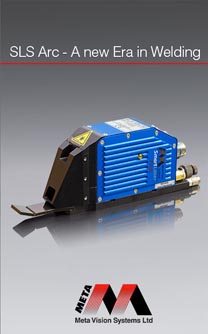News
-
March 14, 2017


Oxfordshire Apprentice of the year

Meta's Oliver Steer has achieved the Apprenticeship Award in Electrical Engineering 2017.
Ollie's accomplishment follows in the footsteps of Meta Apprentice David Sawyer who was awarded Oxfordshire Apprentice of the year in 2015.
-
September 14, 2015


Meta Turns Laser Tracking Inside Out
04/10/2012Meta Vision Systems has released a new version of its VistaWeld laser tracking system for controlling the position of the internal welding head on spiral pipe mills.
There are two conventional ways of controlling the position of the weld head inside a pipe. In the first method, the laser sensor is mounted directly to the internal head and controls its position by sensing the joint directly ahead of the point of welding. The disadvantage is that there may not be enough space for the sensor inside pipes of small diameter. Another problem in two-step mills is that the internal environment is severe due to the volume of weld spatter.
This led to the development of the second traditional method in which the sensor is mounted outside the pipe on an additional servo slide. The sensor can track the joint dynamically from the outside, as the weld head inside the pipe is mounted on a similar servo slide which mimics the action of the external slide. The disadvantage of this approach is its high cost and complexity, as it requires an expensive additional servo slide system for the sensor only. Moreover, the machine operator has to synchronise both sensor and weld head slides before welding can begin.
Meta's new method has the advantage of placing the sensor on the outside of the pipe but without the disadvantage of a separate sensor slide. The company has developed a new calibration method which, combined with Meta’s high resolution Smart Laser Sensor (SLS), means that the laser sensor can be mounted in a fixed position on the outside of the pipe yet control the position of the weld head accurately inside the pipe. Since the sensor is fixed, there is no need for a separate sensor slide.
The new inside-out VistaWeld SLS tracking system has already been installed on several spiral mills, with good results. It is applicable equally to one-step and two-step mills.
Bob Beattie, Meta’s MD, commented: “Over the past fifteen years, we have supplied many systems for spiral pipe mill ID welding and have acquired a lot of experience in the application.
"Even though we developed some very small laser sensors for going inside, previously there was always a restriction on minimum pipe diameter, whereas with this new approach there is no limitation.
"Accurate laser tracking is now available for ID welding on pipe of any diameter. What’s more, the sensor provides accurate as-welded mismatch measurement that can be monitored by mill operators or used as the input to an automatic mismatch control system.”
Release no: 1044(PR)
-
June 1, 2015


Meta starts KTP project on Weld Inspection with Oxford Brookes University
Meta extends R&D programme on Weld Inspection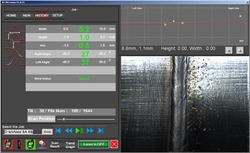
Meta is pleased to announce that it has partnered with Oxford Brookes University to start a new R&D project on 3D weld inspection. The two year project will be run under the UK government's Knowledge Transfer Partnership (KTP) scheme which aims to encourage links between universities and companies.
Jonathan Moore, Meta's Technical Director, commented "We are very pleased to be developing our relationship with Brookes in this way and look forward to a highly successful project in a key area for us. We have seen a rapid increase in interest in automated weld inspection over the last few years, so we felt that the time was right to build on our existing expertise by working together with the academic community."
Further details can be found at: http://www.brookes.ac.uk/business-and-employers/knowledge-transfer-partnerships/ktp-case-studies/sensing-a-good-weld--new-applications-in-computer-vision-2015/
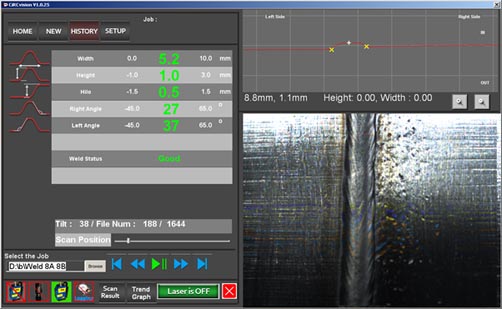
-
December 5, 2014


Meta launches digital remote control system for submerged arc welding
New version of Meta's patented MetaView system releasedMETA launches digital remote
control system for arc welding
Meta Vision Systems (Oxford, UK and Montreal, Canada) has launched a new, all-digital version of its patented MetaView system. It combines a laser-camera sensor head with a video monitor to allow a machine operator to control from a remote location both the horizontal and vertical positions of a SAW (submerged arc welding) head.
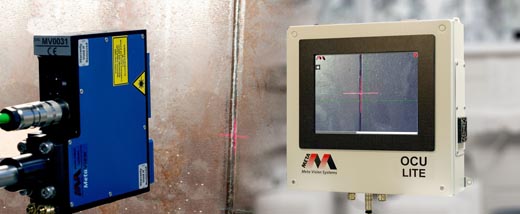
The digital version uses a colour touchscreen as the video monitor. Combined with a new, high resolution digital colour camera in the sensor head, it provides much improved image quality and noise immunity, together with many new features.
Bob Beattie, Meta’s MD, commented, “As an entry-level product, our MetaView system provides a user-friendly way of getting machine operators away from the welding head. At the same time, it actually improves their control over the position of the head in the joint, leading to better weld quality.
“Just as improved health and safety concerns rightly discourage operators from working at heights, so there is an analogous need for a system to allow welding machine operators to work remotely from a safe distance.”
In addition to providing a better, less noisy image, the digital MetaView’s functionality includes digital zoom, pan and tilt, enabling the operator to optimise the image to his or her preference. New also is the ability to add a second camera to provide an overview of the weld head to complement the detailed positional view provided by the MetaView sensor.
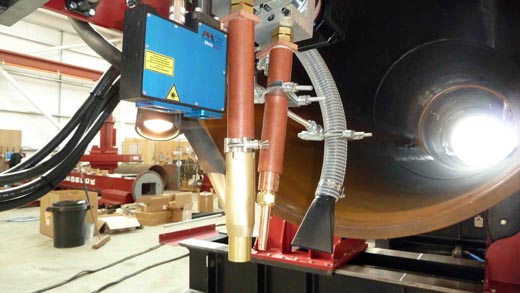
Release no: 1051(PR) (download PDF)
-
September 19, 2014


META to launch new robot welding sensor at Fabtech
Meta Vision Systems (Oxford UK and Montreal Canada) announces the launch of a new laser sensor at the forthcoming Fabtech show in Atlanta, Georgia, to be held from 11th to 13th November 2014.
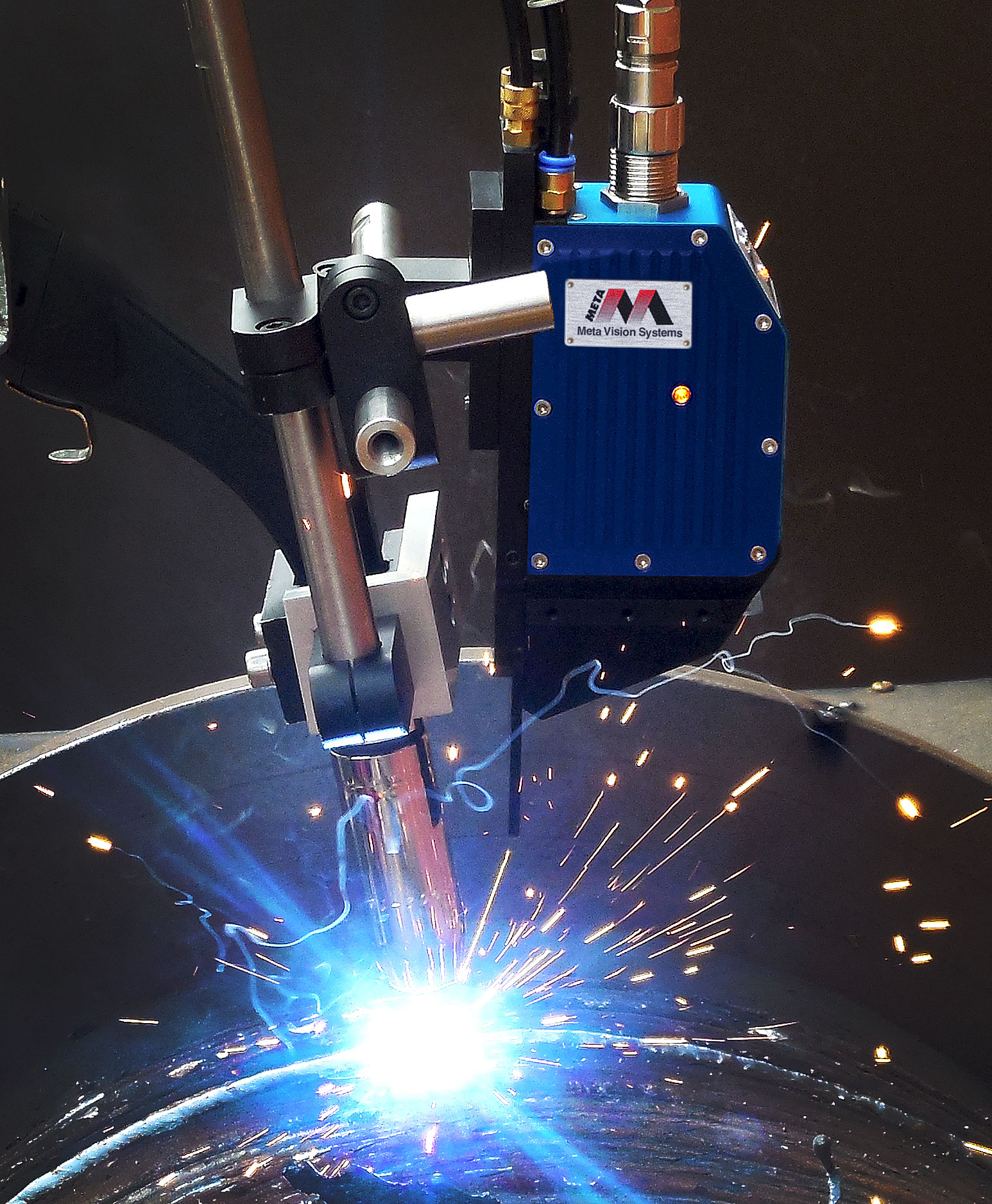
Known as SLS ARC, the new model is an extension of Meta’s successful range of Smart Laser Sensors, optimised for robotic arc welding applications. It is suitable for seam finding and real-time weld seam tracking in all of the usual welding processes, including high current GMAW and FCAW.
Steve Thacker, Meta’s General Manager, commented “Meta was spun out of Oxford University in 1984 to commercialise a research project that developed a laser vision sensor for use in robotic MIG welding in the automotive industry. The SLS ARC represents the latest development in a thirty-year sequence which started with that first Meta sensor.
“The automotive sector represents an important and still growing part of our business, and one where we have had very good recent success. We felt it was timely to build on that success with a new sensor fine-tuned for aggressive robot welding applications. The ARC is just one part of an overall product development plan aimed at extending the state of the art in robot welding.”
By using some of the inherent advantages of SLS technology, including fully automatic image quality optimisation, combined with new sensor optics and a mechanical design matched to the requirements of robot arc welding, the SLS ARC provides a high performance laser sensor in a rugged package as demanded by the automotive industry.
The SLS sensor series is the cornerstone of Meta’s Smart Laser Pilot (SLPi) system, which exploits direct Ethernet connection from the sensor head directly to the robot controller to give excellent seam finding and real-time tracking performance with a simple system hardware architecture.
Jonathan Moore, Meta’s Technical Director, explained “The SLS family has been successful, not only because it was the first welding sensor to include the image processing inside the sensor head, but also because it encompassed several new developments and ways of improving particular features, all of which resulted in better performance while achieving a very competitive price. The ARC takes that approach one step further by using the technology features in the best possible combination for robot arc welding.”
Release no: 1050(PR) (download PDF)
-
February 24, 2014


New Generation Laser Sensor Increases Quality & Speed of Welding
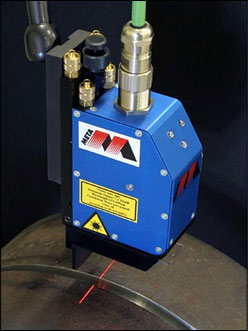
A new laser sensor has been launched by British manufacturer, Meta Vision Systems, for all types of mechanised and robotic welding. It is the first such sensor to incorporate high performance image processing in the sensor head itself, rather than needing a separate computer, and has many applications throughout manufacturing industry.
The thickness of the steel plates that form the base of a wind tower can be 50 mm or more, while the middle section is fabricated from lighter gauge metal and near the top, the steel is thinner still. Welding of these various gauges requires different procedures. The base is typically prepared with a U joint profile and welding takes place in several passes. The middle section requires a V type joint and is welded in one or two passes. Steel at the top is welded with a simple butt joint preparation. The DLS200 sensor has a fully programmable scan configuration, which means that a wide scan can be used for the U and V joints, but a narrow scan with high resolution can be used for the smaller butt joints.
-
January 21, 2014


META CELEBRATES 30th ANNIVERSARY AT TUBE 2014
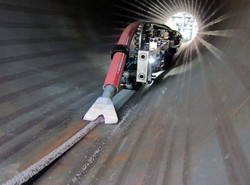
Meta Vision Systems, the leading UK manufacturer of laser guidance systems for automating arc welding, celebrates thirty years of Welding with Vision at the TUBE 2014 exhibition. Meta was a spin-out from Oxford University in 1984, following a successful research project to develop a laser vision system for real-time control of robot welding.
The international show, featuring machinery and accessories for manufacturing and processing of tubes and pipes, will take place in Düsseldorf from 7th – 11th April. Meta will take its largest stand ever, 6B39, and will stage several live demonstrations of new products being launched.
In addition to remaining active in robot welding, the firm has developed considerable expertise in many different tube and pipe applications over the past thirty years and is now generally considered to be one of the leading suppliers of vision and control systems for the tube and pipe industry worldwide.
Within an overall theme of applied innovation, Meta’s stand will show a completely new pipe measurement system. With increasing demands for traceable measurement data from pipe buyers, the manufacturer has harnessed its proven experience in pipe bevel measurement and pipe inspection to develop a suite of new pipe measurement products. They represent a major expansion in the company’s activity in the sector and will be on show for the first time in Düsseldorf.
Meta’s recent developments in longitudinal pipe mills will be highlighted in partnership with Hyundai RB, which has built a new longitudinal pipe mill in Ulsan, Korea, using Meta systems at every stage of the pipe welding process. They are used to control tack welding, ID welding, OD weld joint milling and OD welding. The result is a pipe mill with advanced automation throughout, combining excellent productivity and high quality.
In the spiral pipe sector, Meta will be premiering a new video giving an in depth review of Meta’s new spiral mill control system. This includes mill control, welding control, laser vision and video monitoring, all within a single integrated and networked control system. As a result of Meta’s attention to detail during the design phase, the latest mill control installation was quick and painless for all concerned, enabling the mill operator to start making high quality production pipes in a shorter time than ever before.
Meta looks forward to welcoming its many tube and pipe customers from all over the world to its stand and showing them the latest developments.
-
July 5, 2013


Meta Leads the Way in Friction Stir Welding
Laser tracking equipment manufactured by Meta Vision Systems is being integrated into the latest generation of friction stir welding (FSW) machines built by PTG Heavy Industries at its Elland factory in West Yorkshire. As a result, the internationally successful Powerstir FSW machine range may now be controlled automatically without the need for accurate fixtures.
Several Powerstir machines have already been delivered with Meta's Smart Laser Pilot (SLPi) weld joint tracking system, including to customers in Europe and China.
The work that Meta is doing in this high technology field has led to the firm researching and developing novel applications of FSW under the current EU Framework 7 programme.
FSW was invented and patented by TWI (The Welding Institute) in the UK in 1991 and was adopted by PTG in the development of its world-beating Powerstir machines. Meta, another British company, based in Eynsham, Oxfordshire, has now added its expertise to help automate the process and simplify machine operation.
Being a solid state process, FSW overcomes many of the problems associated with the melting and resolidification of traditional arc welding. A rotating tool is moved along the line of a butt or lap joint, generating frictional heat that softens the material of the parts being joined. Together with carefully controlled clamping, the result is high strength, defect free welding.
Meta's SLPi, which uses the company's high resolution Smart Laser Sensor (SLS), detects the line of the weld joint so that the rotating tool moves exactly along the correct path. With a combination of a mega-pixel camera, high quality uniform laser stripe and special optical and electronics designs, the SLS gives a very high quality joint profile from which the seam position can be extracted reliably. The tool is therefore able to be guided accurately along the line of the joint.
Jonathan Moore, Meta’s Technical Director, commented: “We have supplied tracking and control systems for almost every type of welding and are particularly excited to be involved in FSW and helping PTG with its successful export drive.
"FSW shows great promise in aerospace, shipbuilding and other important sectors. Our involvement with the EU R&D programme is an indication of our commitment to extend our knowledge of this important manufacturing process and further its commercialisation."
Release no: 1045(CS) -
March 20, 2013


Meta Gets Wind of a Big Order in China
UK firm wins major contract from Chinese wind turbine producerOxfordshire-based vision system manufacturer, Meta Vision Systems, has received an order from a large Chinese windtower manufacturer for 14 of its DLS digital laser scanners. They will be used to automate welding operations during production of monopiles for offshore wind installations.
Meta’s DLS is unique among laser vision sensors for welding in that it uses the scanning spot principle rather than the more usual laser stripe method. The scanning spot system has significant advantages when welding the deep joints that are common when manufacturing monopoles, where wall thickness can be over 100 mm.
Dr Jing Zhao, Meta’s Country Manager for China, commented: “We are very happy to have won this contract against tough competition and following a direct comparative evaluation in the customer’s factory.
"The performance of the DLS in generating accurate profiles of deep, narrow weld joints is a significant benefit for our customers. The large depth of the joints results in extended welding times, so continuous, consistent performance over long periods is vital.
"Monopile welding has to be done quickly and efficiently to meet production targets but, at the same time, high quality standards are demanded. This project demonstrates that the quality and productivity benefits of advanced welding automation are persuasive, even in situations where cost considerations are very important.
"Thanks to our emphases on quality and customer satisfaction, the Meta brand is well established and highly respected in China. This important new project gives us an opportunity to reinforce our leadership position in the market there.”
The windtower industry worldwide has become extremely competitive with the evolution of designs that place increasing requirements on fabrication and welding. To be competitive, it is necessary for windtower manufacturers to combine high productivity with excellent quality by using the best practices available.
Meta has extensive experience in the field, having been working on windtower and monopile welding for over fifteen years, with a range of installations in the UK, USA, Canada, China, Korea, Netherlands and elsewhere.
Release no: 1046(PR)
-
October 3, 2011


Improved Digital Control of Spiral Pipe Welding
03/10/2011The world population of spiral pipe mills has increased dramatically over the past ten years and continues to grow. Part of thisexpansion is driven by the acceptance of spirally welded pipe for oil and gas transmission. This application in particular imposes stringent standards on pipe quality and therefore on manufacturing processes.
To meet this need in respect of welding technology, Oxfordshire-based Meta Vision Systems has developed an integrated, networked digital control system as the enabling technology behind what it terms the digital spiral mill. It includes industrial networking, new digital SAW (submerged arc welding) power sources, the latest digital sensors and advanced digital controls.
All can be combined into a single, integrated mill control system. As sensors and controls are accessible, it is possible to improve significantly ease of operation, fault-finding, safety and maintenance. Further benefits include additional functionality, improved ease of operation through better HMIs (human-machine interfaces), integrated data logging and remote access.
New digital welding power sources facilitate a wider range of weld procedures while at the same time being easily interconnected for ease of use. This increases efficiency in various ways while at the same time facilitating accurate parameter control and data reporting.
The latest laser vision sensors from Meta are being used to achieve performance gains in several areas in addition to their established use for weld seam tracking. Laser sensors can now validate weld bevels, in combination with digital signal processing for gap and mismatch control on the mill itself, and inspect weld bead profiles.
Combining mill control and weld control into a single, integrated networked system brings major advantages in terms of performance, reliability, ease of use, safety and cost. Previously, the sensing, welding and control systems were separate. For example, control of the ID and OD weld heads was often from completely independent sub systems. This meant that the respective operators had to inch, start/stop and adjust parameters locally. With an integrated system, such actions can be handled from wherever is most suitable.
The central part of the control system is a pair of networked PLCs (programmable logic controllers). One PLC controls the mill feed section, including coil loading, edge milling and main drives. The second PLC controls the forming and pay-off section, including the weld controls and laser seam tracking.
The HMI to the integrated control system is via a main control console plus a pair of intelligent consoles for the ID and OD operators and the usual local operator stations at work points distributed across the mill.
Stability of operation is a key requirement in the forming section of a spiral pipe mill. Sources of perturbations which impact negatively on stability are camber and strip width variations. One serious problem which can result from lack of stability in the forming section is inconsistent edge milling, which causes problems with forming and welding.
To monitor this, a multi-function measurement system automatically checks edge milling by measuring the bevels. This is becoming even more important with the widespread adoption of two-step spiral mill technology.
During bevel inspection, the actual shape of both sides of the strip is measured continuously by two laser sensors mounted in opposition on each side of the strip, just after edge milling but before pipe forming. If
any out-of-tolerance conditions are identified, various actions can be programmed, ranging from informing the operator to stopping the mill.
There is enormous scope for using advanced sensing and control techniques in the forming and welding section of a spiral pipe mill. Gap control refers to controlling the mill dynamically to ensure good pipe formation and an absence of defects at the ID weld station, where the weld can burn through if the gap opens up too much. Mismatch control refers to the control of the difference in height across the weld. Maximum acceptable mismatch values specified by pipe mill customers are gradually getting smaller.
One example of where mismatch control is especially important is in large diameter water pipe. Controlling the mismatch is more difficult with very large pipe diameters, for example over two metres, and yet water pipe customers are imposing stringent limits on mismatch. This has led to increased interest in automatic mismatch control to satisfy these requirements.
A laser sensor measures the gap, typically just ahead the welding point, and any deviation from target value is used to open or close the mill to maintain a constant gap. It is actually the helix angle that is being controlled, normally achieved by controlling the payoff table although controlling the angle of the feed section is an alternative method.
The sensor can be used for ID weld tracking as well as for gap measurement, although alternative approaches have also been investigated, including combined gap and mismatch control, new mechanical gap measurement sensors and positioning the laser sensor outside the pipe.
An automated mismatch control system that is separate from non-zero gap control has to be designed to cope with the fact that the measurement is being made after welding. A laser sensor makes highly accurate mismatch measurements many times per second, for example to ±0.1mm at 25Hz. The automatic control moves the actuator by exactly the correct amount to eliminate the error. Timing issues are also controlled and performance optimised based on the known positions of the actuator and sensor as well as the mill speed.
In cases where there is no gap and the edge of the incoming strip is pressing tightly against the edge of the newly formed pipe, trying to change the mismatch under these conditions can lead to unpredictable results. The pipe is less constrained than the strip and tends to move more easily, but, depending on the pressure between the two edges, relative movement may not be smooth or well controlled.
When gap and mismatch control are not independent, an alternative regime is possible. In this case, the main focus is on measuring the mismatch, since the gap is always zero, and actuation is by controlling the helix angle.
One big advantage of digital spiral mill architecture is that the welding equipment can be fully integrated with the mill control. This is particularly true in the case of the latest digital SAW power sources, such as Lincoln Electric’s PowerWave AC DC 1000SD. This power source can be relatively easily connected to a mill PLC via a DeviceNet network and also provides easy data logging via an Ethernet connection.
Having the welding equipment integrated with the overall control provides additional functionality and opportunities for system improvement, including improved operator interfaces, customer specific database storage, live parameter monitoring and warning, integrated data logging and remote internet access.
Integrating the weld controls and the laser sensors in the same system also provides an opportunity to use adaptive fill. As well as seam tracking, the laser sensor measures the actual parameters of the weld joint and can adjust the deposition rates to match.
The same type of laser sensor that is used for weld seam tracking can also monitor the weld bead. The laser sensor measures the height and
width of the bead as well as classifying the shape. Such a laser sensor can be integrated, for example, with an online ultrasonic test system, tracking the weld bead to keep the test probes centred. At the same time, the laser sensor measures and classifies the weld bead. This is becoming more important as constraints on weld beads are becoming ever tighter to improve pipe coating.
Release no: 1043(F)


